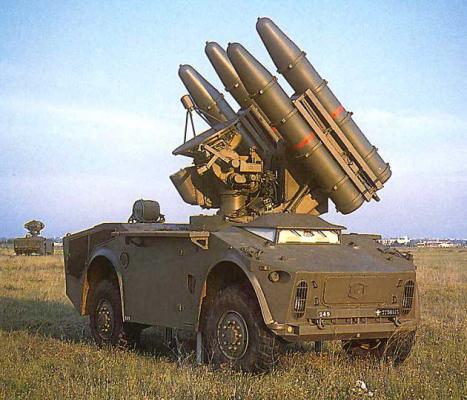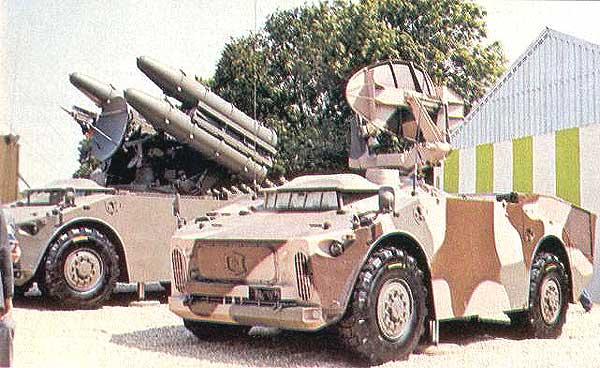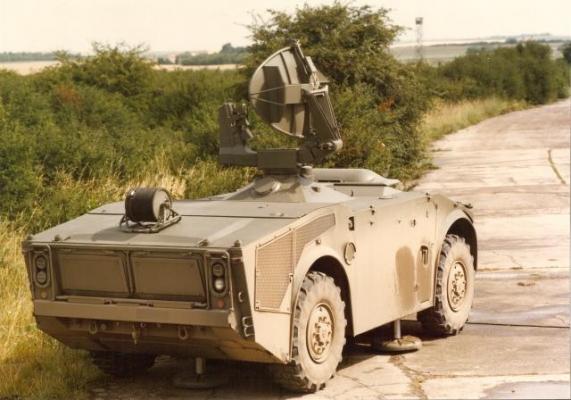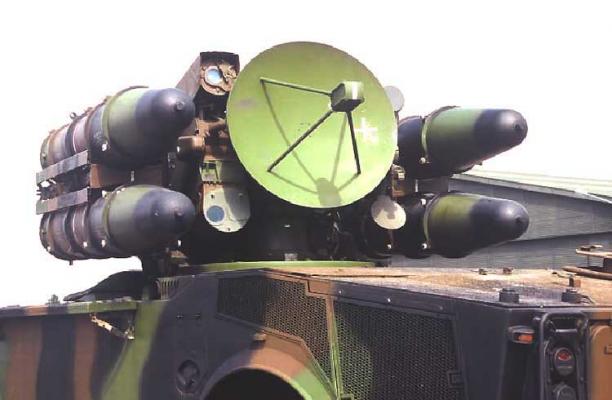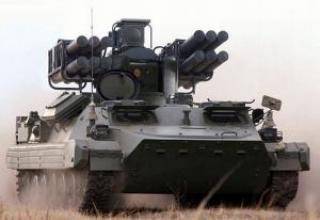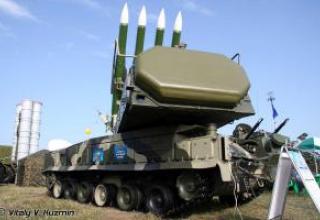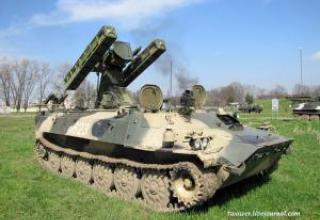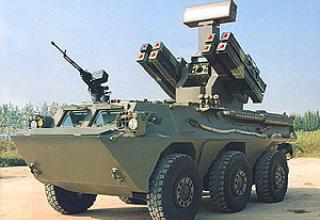In 1964, South Africa signed a contract with the French company Thomson-Houston (later renamed Thomson-CSF) for the construction of a mobile all-weather air defense system designed to destroy targets flying at low and extremely low altitudes. After testing in 1971, the first complexes, named "Cactus", were delivered to South Africa within two years.
In 1972, the Crotale was adopted for service by the French Air Force. After its adoption, the complex was repeatedly upgraded. The first versions of the "Crotale" SAM system were produced under the code "Series 1000". Since 1973, the "Series 2000" was put into production, equipped with a system of identification of state ownership of the target and a TV camera. The "Series 3000", which has an automatic target tracking mode with a TV camera, began production in 1978 and is in service only with the French Air Force. The "4000 Series" has been in production since 1983 and is in service with the French Air Force only. - In this version, radio communication equipment was introduced, which provides information exchange between combat control points at ranges up to 10 km and up to 3 km between the combat control point and the launcher. The "5000 series" combat vehicle is equipped with two additional "Mistral" missiles (1985). Finally, since 1994, an upgraded version of the complex - "Improved Crotale", equipped with a new radar with phased antenna grating.
Currently, potential buyers are offered a complex "Crotale-NG", which has the best tactical and technical characteristics and interference immunity.
The complex was supplied to Bahrain, Egypt, Libya, South Africa, South Korea, Pakistan and other countries.
In 1975, Saudi Arabia ordered a modernized version of the complex on a tracked chassis AMX-30, which was named "Shanine". In addition, Saudi Arabia also purchased the basic version of the Crotale complex, and in 1990, it was purchased by Saudi Arabia. - and a modernized version of the complex to protect its air bases.
For 1996 about 275 complexes (25 of them are sea-based) and more than 7000 missiles were produced.
Composition:
Combat vehicles of the "Crotale" complex (see photo 1, photo 2, photo 3) are mounted on the armored wheeled chassis P4R (4x4 wheel arrangement), the standard platoon consists of a combat control point (ACU) and 2-3 launchers. The battery (division) consists of two platoons. The driver's seat is located at the front of the machine, the operator's workplace and all equipment is centrally located, the engine compartment is at the rear. Crew - 3 people. The engine is carburetor Hotchkiss, part of the machines delivered to the UAE and Qatar, equipped with a diesel Badouin's 6F11 ST . Transmission - electromechanical, suspension - hydropneumatic. In combat position, the launcher is hung on three hydraulic jacks, two of which are located behind the front wheels, one - at the rear of the machine. The machine is equipped with an air conditioning system. Weight of the launcher is 14950 kg, and the combat control center is 12620 kg.
The system can not conduct combat operations in motion, but after a stop it takes less than 5 minutes to be ready for engagement. After detection and capture of the target to escort the missile can be launched in 6.5 seconds.
A combat control point (see photo) provides an overview of airspace, the detection of a target, the identification of its nationality and the recognition of its type. Pulse Doppler radar detection "Mirador-IV" E-band is mounted on top of the chassis, has an antenna rotation speed of 60 rpm and is able to detect low-flying targets at a range of 18.5 km, having a flight speed in the range from 35m / s to 400m / s and a height of several tens to 4500m. The equipment of the combat control station includes: a SN 1050 computer operating in real time, a panel with displays and communication equipment transmitting information in digital code to the launchers. The radar can detect up to 30 targets with the allocation of 12 most dangerous ones for automatic tracking. As soon as a target is detected, its identification is made: the information that the target is an alien aircraft is shown on the display. Target data are transmitted via communication equipment to one of the launchers, where there are combat-ready missiles.
In the "Crotale" complexes "series 1000/2000/3000" after the march is necessary cable connection between the combat control room and the launchers, with a maximum cable length of 800 m. Thus, the time to bring the complex into a combat position was a significant value. The "4000 series" complexes are equipped with LIVH (Liaison Inter Vehicule Hertzienne) radio communication equipment and a mast device. In addition to a significant reduction in time to put the complex on alert and increase the distance between the combat control point and the launchers, its interference immunity was increased. The complex was able to conduct combat operations without radar radiation - with the help of a thermal imaging camera that provides target and missile tracking both in day and night conditions.
The launcher is equipped with a monopulse radar for guidance of J-band (12-18 GHz) missiles with the far border of the detection zone up to 17 km and 4 containers for missiles (two on each side) (see photo 1, photo 2, photo 3). A pointing radar can accompany one target and point up to two missiles simultaneously. Rockets launched at an interval of 2.5 s after 6.5 s after detecting a target are captured by a 1.1° wide radar with an IR tracking system. The range of the infrared tracking system is 14 km. Command transmitter on board the missile works in I-band.
All the chassis are combined with the help of radio lines in a kind of network, and it is possible to transfer information to the launcher not only from the combat control room, but also from another launcher.
There are no missiles on the launch chassis, so spare missiles are transported in a special vehicle and recharged with a light crane in 2 minutes.
The R440 missile is permanently in a transport and launch container. The total weight of the missile with the TPC is 100 kg. The shrapnel blast warhead is located in the central part of the missile body. The striking radius of the shrapnel is 8m, and the speed of flight reaches 2.3 km/s. The combat unit is undermined by an IR non-contact or duplicate contact fuse. Since 1985, the rocket complex "Crotale" is equipped with a modernized fuse model FPE firm "Thomson-CSF". The Bayern-chemie protac solid fuel dual-mode rocket engine (see diagram) provides 20550N thrust at the starting section of the trajectory during 1.75s and 17550N - at the march section during 2.3s at the combustion chamber pressure of 120atm and 90atm respectively. The mass of charges is 16.1 kg and 19 kg. The missile reaches its maximum velocity of 750 m/s during the 2.8s flight.
The sea version of the Crotale Naval complex is equipped with a modified R440N missile.
The target range with an EPR of 1m2, moving at zero speed of 50m/c is 0.5-10km, at 250m/c - 0.5-9.5km. The target acquisition range with the non-zero parameter and speed 50m/s is 0.5-9.7km, with speed 250m/s - 2.0-5.5km. The maximum range at which the Crotale complex can destroy targets with low radial velocity (e.g. a helicopter) is 14.6 km. The probability of hitting a target with one missile is 0.8 and increases to 0.96 when two missiles are fired at the target.
In early 1987, was tested a new combat unit for a missile complex "Crotale". It used the spatio-temporal convergence technology to create an area of flying debris in the form of a belt with a diameter of 40 cm formed at a range of 5-8 m from the target, depending on the value of the missed missile. The combat unit allows to punch a steel plate up to 10 mm thick.
Characteristics:
| Target kill altitude, km | 0.015 - 5 |
| Range, km | 0.5-10 |
| The length of the rocket, mm | 2890 |
| Body diameter, mm | 150 |
| Wingspan, mm | 540 |
| Mass of the rocket, kg | 84 |
| Type of combat unit | directional shrapnel |
| Weight of combat unit, kg | 15 |
| Maximum speed, m/s | 750 |
| Characteristics of R440 missile on overload: | ||
| Flight range, km | Overload value, g | It's flight time, sec |
| 5.0 | 27 | 10 |
| 6.0 | 18 | 13 |
| 10.0 | 8 | 28 |
| 13 | 3 | 46 |
| Fighting vehicle | ||
| Length, m | 6.22 | |
| Width, m | 2.72 | |
| Height, m | 1.93 | |
| Clearance, m | 0.450 | |
| Speed of travel, km/h | 70 | |
| Power reserve, km | 600 | |
| Overcoming climb at 2 km/h | 40% | |
| Overcoming climb at 25 km/h | 10% | |
Testing:
The first combat use of the S-200 SAM system took place in 1982 in Syria, where at a distance of 190 km the E-2C "Hawkeye" DRLO was shot down, after which the American aircraft carrier fleet withdrew from the Lebanese coast. The Libyan S-200 complexes took part in repulsing an attack by American FB-111 bombers and possibly shot down one bomber.
On the basis of the 5B28 anti-aircraft missile of the S-200B complex a hypersonic flying laboratory "Cold" has been created to test hypersonic direct-flow air jet engines. The choice of this missile was based on the fact that the parameters of its flight path were close to those required for flight tests of the Hyper-Sonic Propulsion System. It was also considered important that the missile had been decommissioned and its cost was low. The missile's combat unit was replaced by the head compartments of the GLL "Kholod", which housed the flight control system, a liquid hydrogen tank with displacement system, a hydrogen flow control system with measuring devices and, finally, the experimental HPVRD E-57 of axially symmetric configuration.
Sources:
- Description Crotale Missile sol-air
- Crotale SAM
- Thomson-CSF Airsys Crotale low-altitude surface-to-air missile system Development / "Pakistan Military Consortium"/
- Systeme d'armes CROTALE EVA
- Василин Н.Я., Гуринович А.Л. "Зенитные ракетные комплексы" .-Мн.: ООО "Попурри", 2002- 464с.
- Bayern-chemie protac
